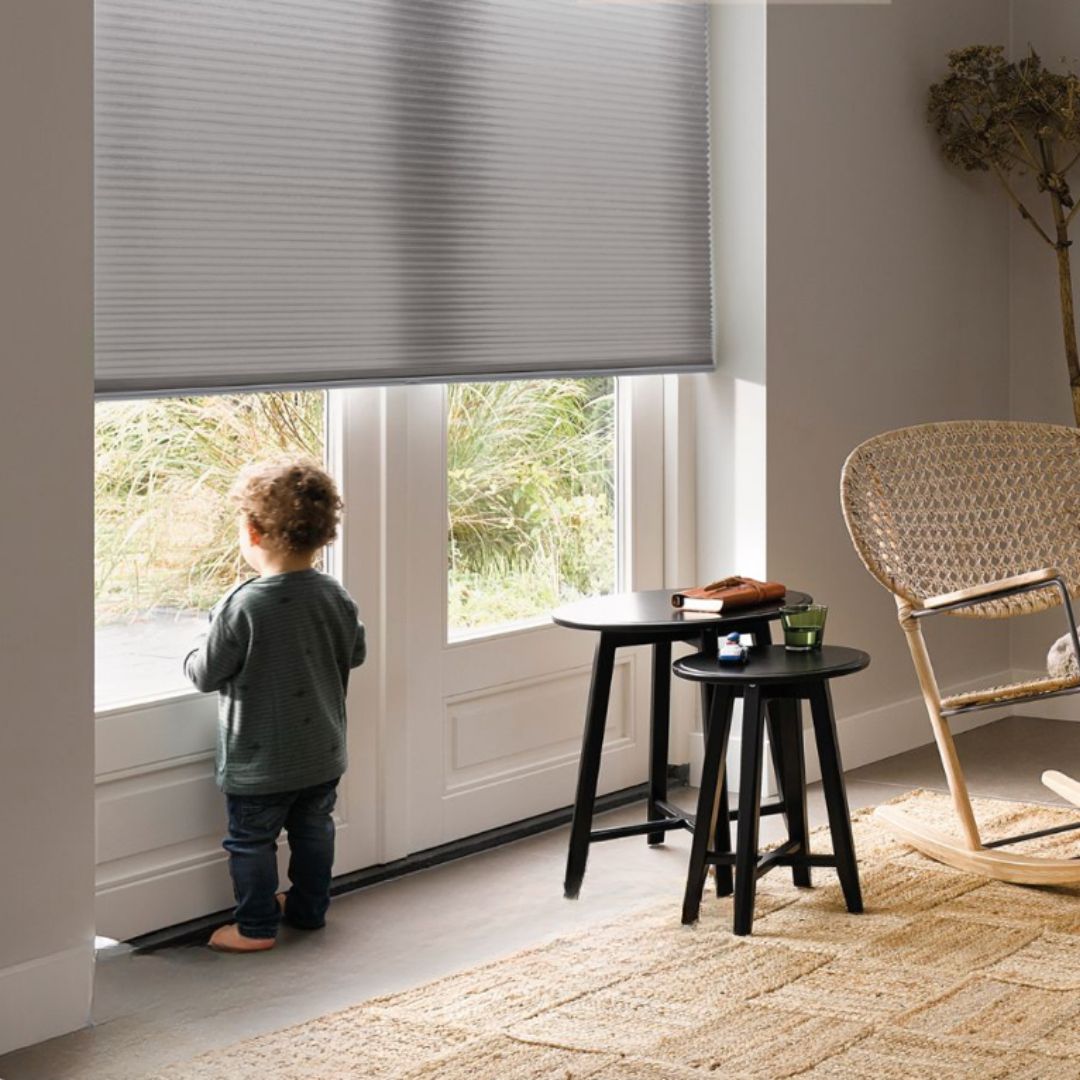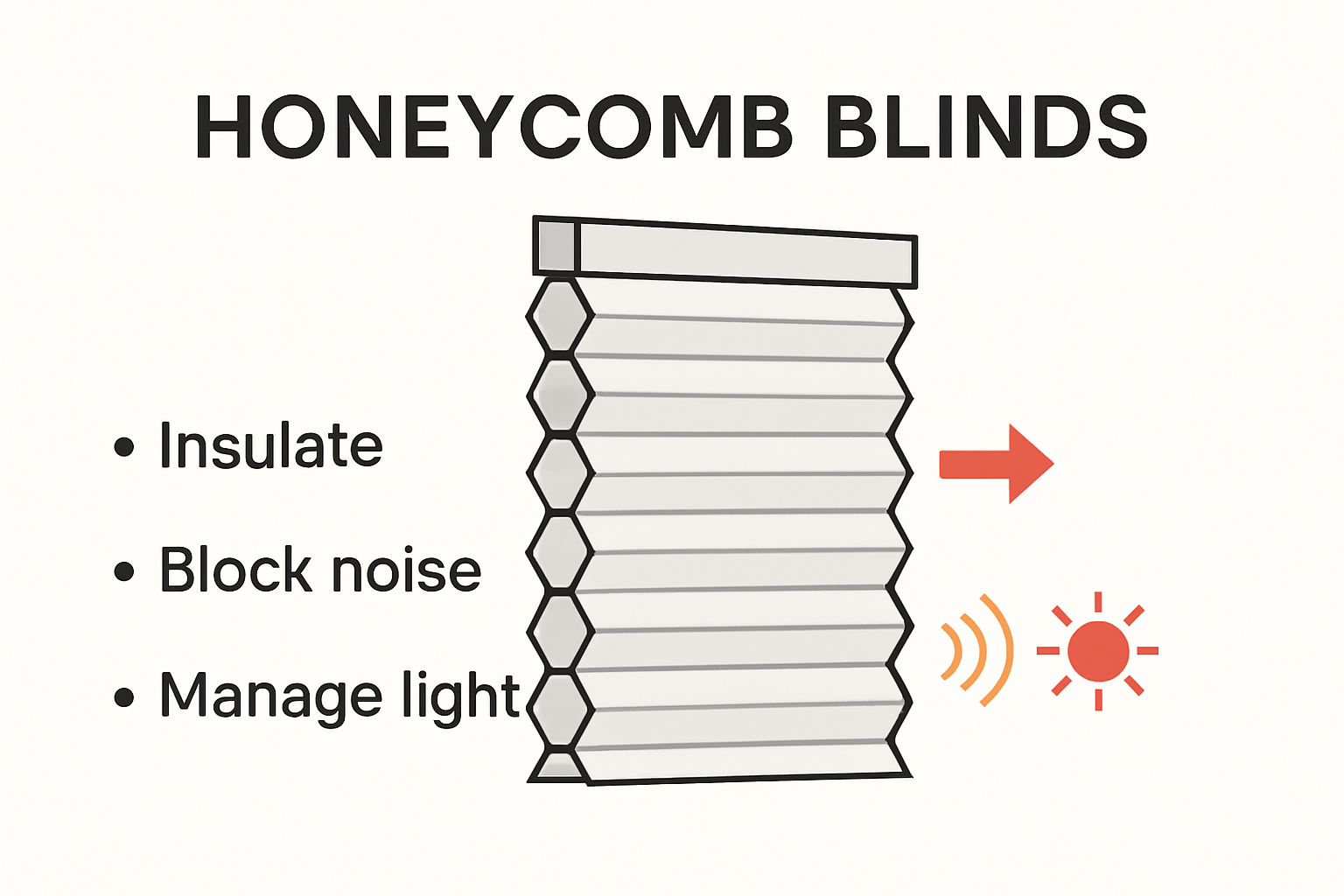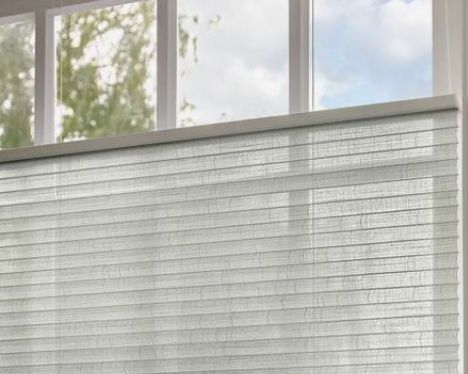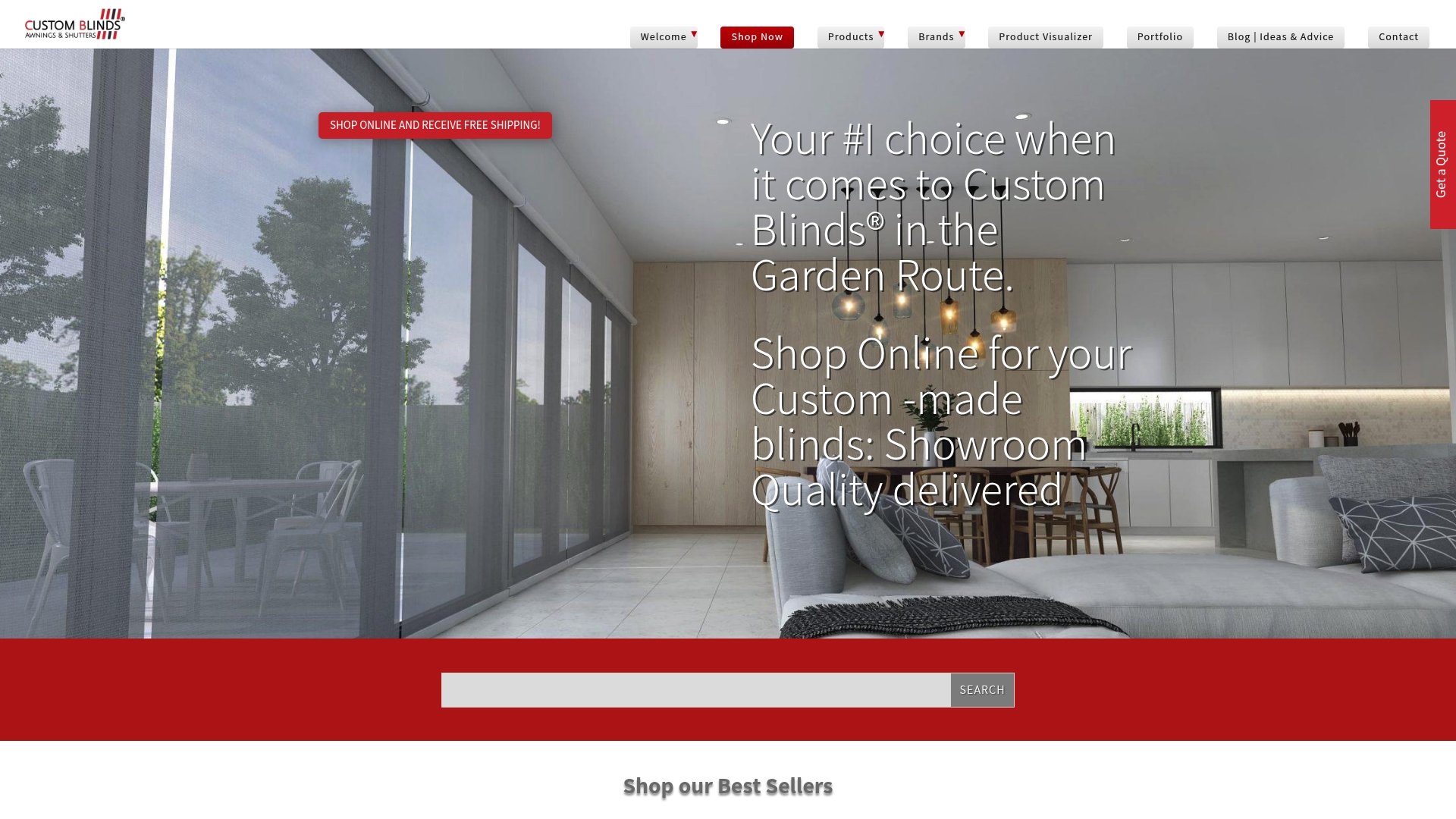What are Honeycomb Blinds? Showroom Quality for SA Homes 2025
Honeycomb blinds are turning heads in South African homes. These blinds can slash your heating and cooling costs by up to 30 percent, and that stat alone grabs attention in a country with energy bills on the rise. Here’s the twist. They are not just about saving money or keeping the heat out. The real surprise is how they block out noise and bring a sleek, modern look to any space. The humble window blind just got a serious upgrade.
Table of Contents
- Understanding What Are Honeycomb Blinds
- Key Benefits For South African Living
- Different Types And Design Choices
- Choosing And Installing Honeycomb Blinds Locally
Quick Summary
| Takeaway | Explanation |
| Honeycomb Blinds Enhance Energy Efficiency | Honeycomb blinds significantly reduce heat transfer, providing thermal insulation that can decrease heating and cooling costs by up to 30%, making them ideal for South African homes with extreme temperature variations. |
| Variety of Customization Options | Available in numerous cell sizes, colors, and opacity levels, honeycomb blinds allow homeowners to tailor their window treatments for both aesthetics and functionality, ensuring a perfect fit for diverse interior styles. |
| Professional Installation Maximizes Performance | Accurate measurement and professional installation are critical for ensuring honeycomb blinds function optimally. Local experts offer tailored advice that considers the unique architectural features and environmental challenges of South African homes. |
| Acoustic Insulation Benefits | Beyond thermal regulation, honeycomb blinds provide sound absorption, effectively reducing external noise and enhancing indoor comfort, especially for those living in urban or noisy environments. |
Understanding What Are Honeycomb Blinds
Honeycomb blinds represent a sophisticated window covering solution that transforms how South African homeowners manage light, temperature, and privacy in their living spaces. These innovative window treatments feature a unique cellular design that sets them apart from traditional blinds and curtains.
The Cellular Architecture of Honeycomb Blinds
At the core of honeycomb blinds is an ingenious structural design that mimics the precision of a honeycomb. Each blind is constructed with multiple soft fabric cells stacked vertically, creating distinct air pockets that serve multiple functional purposes. According to the Department of Energy, these cellular structures provide exceptional thermal insulation, significantly reducing heat transfer through windows.
The distinctive air chambers work like tiny thermal barriers, trapping air and creating a buffer between indoor and outdoor temperatures. In the challenging South African climate, where temperatures can fluctuate dramatically, this design becomes particularly valuable. During scorching summer days, these blinds help keep interiors cool by blocking solar heat. Conversely, in cooler winter months, they retain interior warmth, effectively reducing energy consumption and providing year-round comfort.
Performance and Practical Benefits
Beyond thermal regulation, honeycomb blinds offer remarkable versatility. Research from the National Renewable Energy Laboratory confirms that cellular shades can reduce heat loss through windows by up to 40% during winter and minimize solar heat gain by approximately 60% during summer. This performance translates directly into energy savings and improved household comfort.
The acoustic properties of honeycomb blinds are equally impressive. The cellular structure acts as a sound-absorbing mechanism, dampening external noise and creating a more peaceful indoor environment. Whether you live near busy streets in urban areas or in coastal regions with persistent wind, these blinds provide an additional layer of acoustic insulation.
Customization is another hallmark of honeycomb blinds. Available in various opacity levels – from sheer light-filtering options to complete blackout configurations – they allow precise control over natural light and privacy. Homeowners can select from multiple cell sizes, colors, and operational styles to perfectly complement their interior design and functional requirements.
While traditional window coverings often compromise between aesthetics and functionality, honeycomb blinds represent a sophisticated solution that delivers on both fronts. Check out our guide on selecting the perfect window treatments to explore how these innovative blinds can transform your living spaces.
To help you compare the different types of honeycomb blinds based on their structure and benefits, see the summary below.
| Cell Type | Insulation Level | Suitable For | Description |
| Single-Cell | Standard | Moderate climates | Basic thermal and sound regulation |
| Double-Cell | Enhanced | High temperature variations | Extra air pocket for better insulation |
| Triple-Cell | Maximum | Extreme climates, energy-saving | Superior thermal and acoustic performance |
Key Benefits for South African Living
South African homes face unique environmental challenges that demand versatile and intelligent window covering solutions. Honeycomb blinds emerge as a sophisticated answer to these specific regional requirements, offering unparalleled benefits tailored to the diverse and dynamic living conditions across our beautiful country.
Climate Control and Energy Efficiency
In a country with dramatic temperature variations like South Africa, where summers can scorch and winters can chill, honeycomb blinds provide critical thermal regulation. According to the South African Bureau of Standards, energy efficiency in residential spaces is increasingly important, and these innovative blinds deliver exceptional performance.
The cellular design creates a unique air pocket system that acts as a natural insulator. During intense summer heat, these blinds block solar radiation, preventing indoor spaces from becoming unbearably warm. Conversely, in cooler regions like the Cape or during winter months, they retain interior warmth, reducing reliance on heating systems. Research from the National Energy Efficiency Agency suggests that proper window treatments can reduce heating and cooling costs by up to 30%, making honeycomb blinds a smart investment for budget-conscious homeowners.
Adapting to Diverse South African Environments
South Africa’s landscape is remarkably diverse, from coastal areas battling salt-laden winds to inland regions experiencing extreme temperature fluctuations. Honeycomb blinds offer remarkable adaptability across these environments. Their moisture-resistant fabrics make them ideal for humid coastal regions like Durban, while their thermal properties benefit homes in more extreme climates like the Karoo.
Sound insulation is another critical benefit, particularly for urban dwellers or those living near busy roads. The multi-layered cellular structure effectively dampens external noise, creating a peaceful indoor sanctuary. Acoustic research from the Council for Scientific and Industrial Research confirms that well-designed window treatments can reduce noise transmission by significant margins.
Aesthetic Versatility and Practical Design
Beyond functional benefits, honeycomb blinds offer aesthetic flexibility that complements various South African interior design styles. Available in numerous colors, opacity levels, and cell sizes, they can seamlessly integrate into modern minimalist homes, traditional spaces, or eclectic urban apartments. The clean, streamlined appearance adds a touch of contemporary sophistication to any room.
Privacy control is another significant advantage. Homeowners can select from light-filtering to complete blackout options, allowing precise management of natural light and maintaining interior privacy. This is particularly valuable in densely populated urban areas or homes with close proximity to neighbors.
For those seeking to enhance their living spaces with intelligent, stylish window solutions, explore our comprehensive guide to window treatments and discover how honeycomb blinds can transform your home environment. Each installation represents not just a window covering, but a smart investment in comfort, energy efficiency, and aesthetic appeal.
Here’s a quick table highlighting the main benefits of honeycomb blinds for South African homes.
| Benefit | Description |
| Energy Efficiency | Can reduce heating/cooling costs by up to 30%, ideal for extreme SA temperature variations |
| Acoustic Insulation | Cellular structure dampens external noise, adds comfort for urban or busy-living environments |
| Adaptability | Suitable for diverse regions, from humid coasts to inland regions with temperature extremes |
| Aesthetic Versatility | Wide colour, cell-size and opacity options suit all interior styles |
| Privacy Control | Light-filtering to full blackout choices for anywhere |
| Moisture Resistance | Ideal for coastal homes with high humidity |
Different Types and Design Choices
Honeycomb blinds represent a versatile window covering solution with an impressive array of design options tailored to meet diverse South African home requirements. Understanding the various configurations allows homeowners to make informed decisions that perfectly match their aesthetic and functional needs.
Cell Structure and Insulation Configurations
The fundamental design of honeycomb blinds revolves around their cellular structure, which determines thermal performance and visual appeal. According to the South African Fenestration and Glazing Association, these blinds are available in single, double, and triple-cell configurations, each offering progressively enhanced insulation capabilities.
Single-cell honeycomb blinds provide standard thermal regulation and are ideal for moderate climate zones. Double-cell designs offer improved energy efficiency, creating an additional air barrier that significantly reduces heat transfer. Triple-cell configurations represent the pinnacle of thermal engineering, delivering maximum insulation for homes in regions experiencing extreme temperature variations.
Cell sizes also vary, typically ranging from 10mm to 25mm, allowing homeowners to select designs that complement their window dimensions and interior styling. Smaller cells create a more delicate, refined appearance, while larger cells provide a bold, contemporary aesthetic.
Opacity and Light Management Options
Customization extends beyond structural design into light management capabilities. Research from the National Renewable Energy Research Centre highlights the importance of adaptive light control in residential spaces. Honeycomb blinds excel in this domain, offering multiple opacity levels to suit different environments and preferences.
Sheer fabrics allow soft, diffused light transmission while maintaining exterior views, perfect for living areas and spaces requiring natural illumination. Light-filtering options provide enhanced privacy without completely blocking daylight, creating a balanced indoor atmosphere. Blackout configurations offer total light exclusion, ideal for bedrooms, home offices, or media rooms where complete darkness is desired.
Color selections further enhance design flexibility. From neutral tones that blend seamlessly with existing decor to bold statements that become focal points, honeycomb blinds can be tailored to individual aesthetic preferences.
Operational Mechanisms and Smart Integration
Modern honeycomb blinds transcend traditional manual operation, embracing technological innovations that enhance user experience. The Smart Home Technology Association recognizes the growing trend of integrated window solutions that offer convenience and efficiency.
Traditional corded systems remain available for those preferring classic approaches. Cordless mechanisms provide a cleaner aesthetic and improved child safety, eliminating dangling cords. Top-down/bottom-up configurations allow unprecedented light and privacy control, enabling users to adjust blinds from either the top or bottom of the window.
Motorized honeycomb blinds represent the pinnacle of contemporary design, integrating seamlessly with smart home ecosystems. These advanced systems can be programmed, voice-activated, or controlled via smartphone applications, offering unprecedented convenience and energy management.
Explore our comprehensive guide to selecting the perfect window treatments and discover how honeycomb blinds can transform your living spaces with style, functionality, and technological sophistication.
Choosing and Installing Honeycomb Blinds Locally
Selecting and installing honeycomb blinds in South African homes requires careful consideration of local environmental conditions, personal preferences, and professional expertise. Understanding the nuanced process ensures homeowners make informed decisions that enhance both aesthetic appeal and functional performance.
Measuring and Assessment Considerations
Accurate measurement represents the critical first step in selecting honeycomb blinds for local installations. According to the South African Fenestration and Glazing Association, precise window measurements are essential for achieving optimal fit and performance. Professional installers recommend measuring window width and height at multiple points, accounting for potential architectural variations common in South African home designs.
Window orientation plays a significant role in blind selection. South African homes experience diverse sunlight exposure depending on regional location. Coastal areas like Cape Town demand different considerations compared to inland regions such as Johannesburg. Factors like direct sunlight intensity, wind exposure, and temperature variations influence fabric and cell configuration choices. For instance, homes in the Western Cape might require different opacity levels compared to properties in the Northern Cape due to distinct environmental characteristics.
Professional Installation and Local Expertise
While DIY installation might seem tempting, professional intervention ensures precision and long-term performance. Research from the Construction Industry Development Board emphasizes the importance of skilled installation in maximizing window covering effectiveness. Local experts understand regional architectural nuances and can recommend specific mounting techniques that account for unique structural challenges.
Professional installers provide comprehensive services beyond mere measurement and hanging. They assess window frame conditions, recommend appropriate mounting brackets, and ensure seamless integration with existing interior design elements. In regions experiencing significant temperature fluctuations or high humidity levels, specialized installation techniques become crucial for maintaining blind functionality and longevity.
Maintenance and Local Support Considerations
Maintaining honeycomb blinds requires understanding local environmental challenges. South African homes face diverse conditions ranging from coastal salt air to inland dust and temperature extremes. The South African Bureau of Standards recommends regular maintenance to preserve blind quality and performance.
Local suppliers often provide specialized cleaning and maintenance advice tailored to regional conditions. Dust management in areas like the Karoo, moisture control in coastal regions, and UV protection strategies differ significantly. Professional local providers understand these nuanced requirements and can offer targeted maintenance recommendations.
Custom color selections and fabric choices should align with local interior design trends while maintaining functional performance. South African homes often blend contemporary and traditional design elements, demanding versatile window covering solutions that complement diverse architectural styles.
You may also be interested in
Discover our comprehensive local installation guide to understand how professional expertise transforms your window treatment experience. Our team combines local knowledge with international design standards, ensuring your honeycomb blinds deliver exceptional performance and aesthetic appeal.
Frequently Asked Questions
What are honeycomb blinds?
Honeycomb blinds are innovative window coverings featuring a unique cellular design that provides excellent thermal insulation and energy efficiency, helping to regulate indoor temperatures and reduce energy costs in South African homes.
How do honeycomb blinds improve energy efficiency?
Honeycomb blinds can reduce heat transfer and maintain comfortable indoor temperatures, potentially decreasing heating and cooling costs by up to 30%. Their cellular structure traps air, providing effective insulation against temperature fluctuations.
Are honeycomb blinds good for noise reduction?
Yes, honeycomb blinds offer significant acoustic insulation due to their layered cellular design, which dampens external noise. This makes them ideal for homes in busy urban areas or noisy environments.
How do I choose the right honeycomb blinds for my home?
When choosing honeycomb blinds, consider factors like cell structure (single, double, or triple), color and opacity options, and the specific need for light management or thermal insulation based on your local climate conditions.
Transform Your Space with True Showroom Quality Blinds
Is your current window solution letting in more heat, cold or street noise than you want? Maybe you are tired of dealing with uncomfortable rooms or rising energy bills. Our article highlighted how proper honeycomb blinds can bring privacy, style and year-round comfort right to your doorstep. If you are searching for a local team who understands the unique challenges of South African homes, you can trust us to offer real solutions that actually work for you—no quick fixes or one-size-fits-all products.
See what genuine expertise and personal service can do for your home. With 15 years of hands-on experience, we bring the latest in honeycomb blind technology with national delivery from Knysna right across South Africa. We will help you select the exact right fit for your space and handle measuring and installation so you save energy, block out unwanted noise and refresh your living style all at once.
Ready to upgrade your home comfort? Visit our main site at Custom Blinds or learn more about our tailored installation process now. Discover the difference that personal service and quality can make—your home and your lifestyle deserve nothing less.





